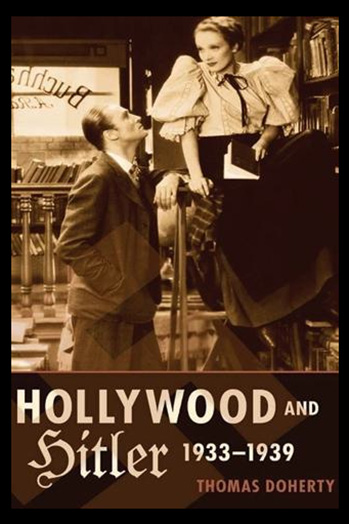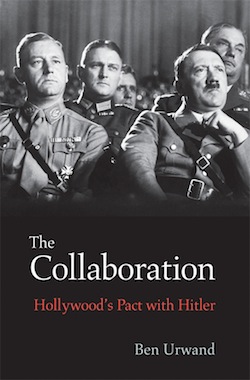It’s been quite a long while since we heard the phrase “Hollywood Jews”. We will soon approach 100 years of debate about the “Jewish influence” in Hollywood, a word that broadly describes the American film and television (and other entertainment) industries in Los Angeles. There’s lots of documentation that shows that:
1. Jews are over-represented in Hollywood, especially in some key creative and some high-profile positions.
2. The Jewish “influence” over Hollywood is overstated by an enormous amount – even by Jews themselves.
3. There are lots of good historical reasons why Jews gravitated to work in the American film and television industries – primary among them because historically they were locked out of a large number of other industries and professions. Hollywood, for a complex set of geographical, historical and economic factors, was open to “the Jews” at a key point in Jewish and film history, and has remained relatively so since.
Here’s what Neal Gabler, in his 1988 book An Empire of Their Own: How the Jews Invented Hollywood, writes with respect to point three: “There were no social barriers in a business as new and faintly disreputable as the movies were in the early years of this century…. There were none of the impediments imposed by loftier professions and more firmly entrenched businesses to keep Jews and other undesirables out.”
And here’s a good example of point number two. Premiere, a monthly film magazine published in the USA from 1987 to 2010, used to present its annual “Top 100 power list”. I analysed the “power list” every year over a ten+ year period (approximately 1995 to 2005), to see how many of the “top 100” on the list were, in fact, Jewish. When I gave lectures on Jewish representation in film, I would ask the audience how many on the list did the audience think were Jewish. These were Australian Jewish audiences, reasonably sophisticated in media, in film and with a high degree of Jewish “awareness”, and not prone to over-estimating Jewish power in the world. The average guess was about 50%, with some people estimating as high as 90%. The lowest estimates – yes, the absolute lowest – only just met the reality: between 22% and 25%. Over the ten or eleven years in my survey, the top number was about 29%, and the lowest 20%.
Okay, so 25% is a lot, you might argue, especially when Jews make up only about 2.5% of the American population. Yes, it’s an over-representation by a factor of ten, but far from control. And the further down the list you go, the fewer Jews actually appeared. I strongly suspect that the second 100 (if totalled) would be significantly less.
So that’s the some of the background of the recent headline coverage of “Hollywood Jews support the Iran deal”, with some pretty strong criticism of the full-page advertisements that appeared in the Los Angeles Jewish Journal last week. We Jews – and many non-Jews, both sympathetic to Jewish causes and not – are pretty alert to “Jewish power” issues. So when the “Hollywood Jews” make a statement together, well … we notice. And we notice a lot more than when it’s a simple group of Jews, because of the nature of Hollywood film history. “Cleveland Jews” making a statement just doesn’t have the same ring to it, does it?
So here, below is a copy of the advertisement. You can find a lot more information on the Hollywood Reporter website. Even The Times of Israel insisted on calling the group “Hollywood Jews”, when the more accurate description – one used by the group itself – was “Los Angeles Jewish leaders”.
 For the record, here is the list of signatories to the ad:
For the record, here is the list of signatories to the ad:
Mel Levine, Mickey Kantor, Eli Broad, Norman Lear, Frank Gehry, Stanley Gold, Irwin Jacobs, David Abel, James Adler, Daniel Attias, Elaine Mitchell Attias, Lawrence Bender, Peter and Barbara Benedek, Michael Berenbaum, Donna Bojarksy, Peter Braun, Rabbi Sharon Brous, David Bubis, Rabbi Ken Chasen, Eli Chernow, Rabbi Neil Comess-Daniels, Bruce and Toni Corwin, Geoffrey Cowan, Bert Deixler, David Fisher, William and Patricia Flumenbaum, Terry Friedman, Abner Goldstine, Rabbi Joshua Levine Grater, Arthur Greenberg, Earl Greinetz, Richard and Lois Gunther, Stephen Gunther, Janet Halbert, Michael Hirschfeld, Elaine Hoffman, Jane Jelenjo and Bill Norris, Charles Kaplan, Marty Kaplan, Steven Kaplan and Janet Levine, Glenn and Miriam Krinksy, Luis and Lee Lainer, Mark Lainer, Peter Landesman, Shawn Landres, Shari Leinwand, Irwin Levin, Peachy Levy, Rabbi Richard N. Levy, Mike Medavoy, Douglass Mirell, Charles Mostov, Allan and Nicole Mutchnik, David N. Myers, Mark and Marsha Novak, Rabbi Arnold Rachlis, Carolyn Ramsay, Gene Reynolds, Victoria Riski and David W. Rintels, Fredric D. Rosen, Rick Rosen, Monica and Philip Rosenthal, Ranni John Rosove, Thomas Safran, Dena Schechter, Rabbi Chaim Seidler-Feller, Larry Shapiro, Abby Sher, Richard Siegel, Glenn Sonnenberg, Carolyn Strauss, Bradley Tabach-Bank and De Dee Dorksind, David A. Thorpe, Larry Title and Ellen Shavelson, Matthew Velkes, Hope Warschaw, Rick Wartzman, Matthew Weiner, Sandford and Karen Wiener, Daniel Weiss, Marcie and Howard Zelikow and Michael Ziering.
It’s an interesting list, with a few well-known names, including Matthew Weiner (“Mad Men”), Eli Broad (philanthropist and entrepreneur), Norman Lear (TV mogul) and Frank Gehry (the architect, not a media person), Mike Medavoy (a genuine Jewish film mogul), Michael Berenbaum (Holocaust film scholar) and Mickey Kantor (former politician). A fascinating group, but (a) not a “power list” of Hollywood personalities (how many do you recognise?); and (b) includes lots of non-entertainment types. Missing are most of the biggest actor, director and producer names. Not exactly what I’d call a “Hollywood Jewish coalition”, by any means.
However it suits the media to frame this as a “Hollywood” (read: film and television) list.




 Posted by donperlgut
Posted by donperlgut 






